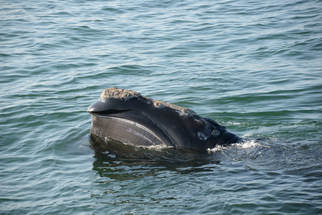biology

- Adults: 45-55 feet long (14-17 meters), 139,700 lb (63,500 kg).
- Calves: 15-20 feet long (4.5-6 meters)
Right whales are in a group of whales called Mysticetes, or baleen whales. Instead of teeth, these whales have baleen, which is composed of keratin, the same material that forms hair, fingernails and horn. The baleen (also called whalebone) is arranged in a series of plates that hang from both sides of a whale's upper jaw, over 200 plates on each side. Each plate can be up to 10 ft in length. The inner edge of the baleen plates is lined with a long, silky fringe, and it acts as a strainer with which to filter their food from the seawater.
Right whales need such an elaborate feeding mechanism because they feed on the smallest creatures in the sea, copepods, which are part of a group of microscopic animals called zooplankton. When right whales find a dense patch of copepods, they swim through the patch with their huge mouths wide open. The copepods enter the mouth with the seawater, then are trapped against the mat of hair-like baleen fringe, while the water passes through the spaces between the baleen plates. In this way, right whales are able to filter out the copepods from the seawater, consuming more than a ton of the tiny creatures in a single day. Right whales need that much food to build up the blubber layer that keeps them warm in the frigid Atlantic waters. They also draw on their blubber when food is scarce and, for females, when meeting the extra demands of breeding and nursing.
